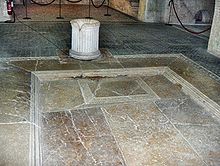- Impluvium
-
 The impluvium of the Roman House in Spoleto, Italy
The impluvium of the Roman House in Spoleto, Italy
The impluvium is the sunken part of the atrium in a Greek or Roman house (domus). Designed to carry away the rainwater coming through the compluvium of the roof, it is usually made of marble and placed about 30 cm below the floor of the atrium.
The name is also used for a type of dwelling typical of the Jola in the Casamance region of Senegal. It is a circular mud building, built with a ring of rooms around a walkway that circumscribes a central water trench, fed by an opening that allows water into the building. Impluvia remain cool in very hot weather as the water evaporates. There is a particularly fine example that serves as a hotel in Enampore. Impluvial architecture is also used by the Igbo, Yoruba and Edo of southern Nigeria, in which they consist of small courtyards cornered with large pots to collect rain water. Edo and Yoruba houses usually consist of several impluvia and courts. The amount and size of these courts depend on the social and economic status of the individual. Royal palaces in Yorubaland and the Kingdom of Benin possessed hundreds of impluvia sometimes floored with elaborate pavements made of potsherds and quartz pebbles arranged in decorative patterns.
Inspection (without excavation) of impluvia in Paestum, Pompei and Rome by an American Civil Engineer indicated that the pavement surface in the impluvia were porous or the non-porous stone tiles were separated by a gap significant enough to allow a substantial quantity of water to stand in the basin of the impluvium, filter through the cracks and through layers of gravel and sand into a holding chamber below ground. The circular stone opening (visible in the photograph resembling a chimney pot) allows easy access by bucket and rope to this private, filtered and naturally cooled water supply. Similar water supplies were found elsewhere in the public spaces of the city with the stone cap showing the wear patterns of much use (the rope wear patterns also are visible in the photograph). In wet seasons, excess water that could not pass through the filter would overflow the basin and exit the building and any sediment or debris remaining in the surface basin could be swept away. In hot weather, water can be drawn from the cistern chamber (or fetched by slaves from supplies outside the domus) and cast into the shallow pool to evaporate and provide a cooling effect to the entire atrium. As the water evaporates, the surrounding air is cooled and becomes heavier and flows into the living spaces and is replaced by air drawn through the compluvium. The combination of the compluvium and impluvium formed an ingenious, effective and attractive manner of collecting, filtering and cooling rainwater and making it available for household use as well as providing cooling of the living spaces.
See also
Categories:- Ancient Greek architecture
- Ancient Roman architectural elements
Wikimedia Foundation. 2010.

